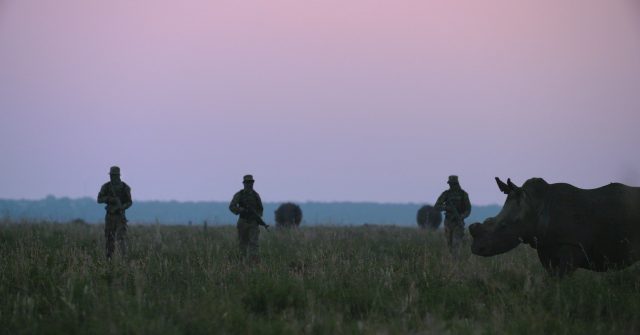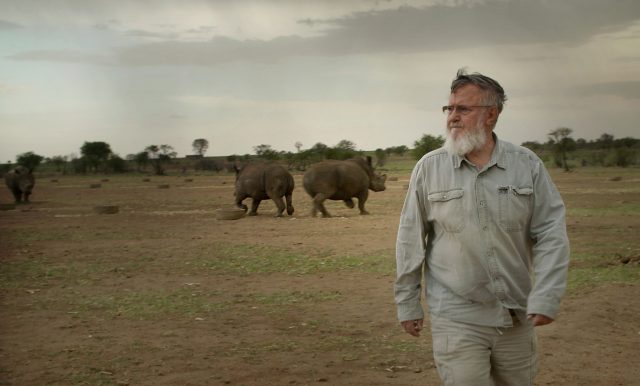
Trophy explores hunting and conservation of wild animals in African in surprising and complex ways
TROPHY (Shaul Schwarz & Christina Clusiau, 2017)
Quad Cinema
34 West 13th St. between Fifth & Sixth Aves.
Opens Friday, September 8
www.trophyfilm.com
quadcinema.com
 In 2015, Minnesota dentist Dr. Walter Palmer shot and killed the beloved Cecil the lion in Zimbabwe, setting off international outrage about trophy hunting. Director Shaul Schwarz and codirector Christina Clusiau explore the much-reviled sport, with surprising results, in Trophy. The film, beautifully photographed in South Africa, Zimbabwe, and Namibia by Schwarz and Clusiau, can be extremely difficult to watch, but it is a must-see even though it includes several scenes of brutal animal shootings, including the harrowing killing of an elephant that cries out after it falls to the ground, its family nearby. But what starts out as a horrific look at hunters who pay seemingly ridiculous amounts of money to hunt the Big Five — it can cost upwards of half a million dollars to shoot a buffalo, leopard, elephant, lion, and rhino — quickly turns into a compelling study of conservation, poaching, and sustainability. “I know that a lot of people are confused how hunting and conservation go together,” Safari Club International Foundation president Joe Hosmer says. Despite a serious decline in the number of lions, elephants, and rhinos in the world since 1900 — the film points out that sixty percent of all wild animals have been lost since 1970 — some argue that hunting is necessary and that breeders are helping keep these animals from disappearing from the planet, while others claim just the opposite. “There’s a big industry in our country, not just the crocodiles — the lions, the sable, the buffalo. Everything has been bred for a purpose,” says Christo Gomes, hunting outfitter for Mabula Pro Safaris. “So, yeah, sure, some of them will be hunted. We as humans are going to eat it, we are going to use the skins; that’s the cycle of life.” Born Free USA CEO Adam Roberts explains, “You can just pick whatever animal you want from the menu that they offer you, see the price, and book the kill.” Ecologist and author Craig Packer sees both sides of the issue but can’t escape the basic idea that “canned hunting [is] not sport; it’s just killing.” South African Predator Association president Pieter Potgieter complains, “If we can’t get hunters to hunt our lions, we slaughter the lions and sell their bones.” Somewhere in the middle is South African wildlife officer Chris Moore, whose job is to find a balance between canned hunting, poaching, and animals that can destroy local families’ livelihoods. “Every single morning I look in the mirror because we’ve got to make sure that we don’t cross the bounds . . . that we can’t lose our humanity for humanity,” he says, acknowledging that some hunting is absolutely necessary to help both the animal population and the people, who are desperately poor, but adding, “We have to keep this fight going.”
In 2015, Minnesota dentist Dr. Walter Palmer shot and killed the beloved Cecil the lion in Zimbabwe, setting off international outrage about trophy hunting. Director Shaul Schwarz and codirector Christina Clusiau explore the much-reviled sport, with surprising results, in Trophy. The film, beautifully photographed in South Africa, Zimbabwe, and Namibia by Schwarz and Clusiau, can be extremely difficult to watch, but it is a must-see even though it includes several scenes of brutal animal shootings, including the harrowing killing of an elephant that cries out after it falls to the ground, its family nearby. But what starts out as a horrific look at hunters who pay seemingly ridiculous amounts of money to hunt the Big Five — it can cost upwards of half a million dollars to shoot a buffalo, leopard, elephant, lion, and rhino — quickly turns into a compelling study of conservation, poaching, and sustainability. “I know that a lot of people are confused how hunting and conservation go together,” Safari Club International Foundation president Joe Hosmer says. Despite a serious decline in the number of lions, elephants, and rhinos in the world since 1900 — the film points out that sixty percent of all wild animals have been lost since 1970 — some argue that hunting is necessary and that breeders are helping keep these animals from disappearing from the planet, while others claim just the opposite. “There’s a big industry in our country, not just the crocodiles — the lions, the sable, the buffalo. Everything has been bred for a purpose,” says Christo Gomes, hunting outfitter for Mabula Pro Safaris. “So, yeah, sure, some of them will be hunted. We as humans are going to eat it, we are going to use the skins; that’s the cycle of life.” Born Free USA CEO Adam Roberts explains, “You can just pick whatever animal you want from the menu that they offer you, see the price, and book the kill.” Ecologist and author Craig Packer sees both sides of the issue but can’t escape the basic idea that “canned hunting [is] not sport; it’s just killing.” South African Predator Association president Pieter Potgieter complains, “If we can’t get hunters to hunt our lions, we slaughter the lions and sell their bones.” Somewhere in the middle is South African wildlife officer Chris Moore, whose job is to find a balance between canned hunting, poaching, and animals that can destroy local families’ livelihoods. “Every single morning I look in the mirror because we’ve got to make sure that we don’t cross the bounds . . . that we can’t lose our humanity for humanity,” he says, acknowledging that some hunting is absolutely necessary to help both the animal population and the people, who are desperately poor, but adding, “We have to keep this fight going.”

John Hume is on a virtual one-man crusade to protect the rhinos in Trophy
One of the central figures in the film is Buffalo Dream Ranch owner John Hume, the world’s largest rhino breeder, who has been selling off his vast assets to maintain the species. Every two years, Hume shaves off his rhinos’ horns so poachers won’t kill the animals in order to get the valuable objects; he firmly believes that the legalization of the rhino horn trade is essential to the survival of the animals. “The odds are stacked against them, and I’m always for the underdog. But more to the point, I got to know them, and they are the last animal in the world that deserves the persecution,” he says. “They don’t deserve it. They are the nicest, most user friendly animal that wants to stay this side of extinction.” Schwarz and Clusiau also follow Texas sheep breeder Philip Glass, a Bible thumper who comes from a hunting family and is seeking to score the Big Five. In describing a kill, Glass says, “And then you pull the trigger, and boom! You got him. And then all of that anticipation changes into a different emotion, of joy, and relief, and excitement, and anticipation, because you want to go over to him and see, what does he look like. What does he feel like. Where did he fall.” But it’s hard to feel much sympathy for the hunters as they clean up their kill, cover up the blood, and then pose for photographs over their trophy. As professional hunter Gysbert van der Westhuyzen, who leads trips in Namibia, says, “You have to work for your trophy. We believe here that if you want to hunt, it’s all in the foot, it’s walk and stalk. It’s also giving the animal a chance.” But he then tears up and heads off camera when asked if he ever gets attached to any of the animals he ultimately releases to be hunted. “There [are] animals you can’t let go of. You know, you will be playing with them and they become like a friend.” The film also includes a breeding auction, a look inside the Safari Club Convention in Las Vegas, a heated court case, and an intense debate over conservation between Hume and Born Free Foundation CEO Will Travers. But then you watch a hunter shoot a crocodile and yell, “It’s party time!” and it’s hard to think of anything other than what’s right in front of you. Schwarz (Narco Cultura) and Clusiau, who previously collaborated on A Year in Space and Aida’s Secrets, have done an outstanding job examining all sides of a surprisingly complex issue, which is about a lot more than just a dentist shooting a gorgeous beast and proudly posing with his victory. Trophy opens September 8 at the Quad with a series of Q&As with Schwarz and Clusiau on September 8 at 6:50 joined by producer Chris Moore and editor Jay Sternberg, September 9 at 6:50 with Time magazine photo editor Kira Pollack, and September 10 at 4:20 and then 6:50 with New York Times international photo editor David Furst.